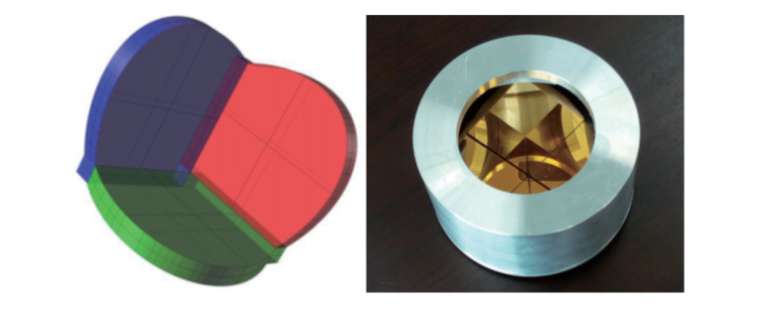Andrew Jones • Feb 07, 2019
Stunning new images show what the Chang'e-4 mission has been up to
China has all but shut down to welcome the Year of the Pig and Yutu-2 is taking a precautionary midday nap, but the Chang’e-4 mission is still sending us some new and brilliant footage from its various spacecraft—while also being snapped by NASA’s Lunar Reconnaissance Orbiter.
Chang'e-4 and Yutu-2, China's mission to the Moon's farside
China's Chang'e-4 mission delivered a landing platform and a rover named Yutu-2 to the Moon's farside.
First up an update on the Chang’e-4 landing party, which is into its second lunar day. Yutu-2 woke up on 29 January and started moving northwest within Von Kármán crater until entering standby mode on 4 January while the Sun is high in the sky. The lander awoke on 30 January after recording a low of -190 degrees Celsius (-310 F) during the lunar nighttime, using a small radioisotope thermoelectric generator.
Then, on 4 February, we got to see newly-released footage of Yutu-2 and the deployment of the five-meter booms for the Low Frequency Spectrometer radio astronomy instrument:
Chang'e-4 new footage, 04 February 2019 This video shows newly released images and video from the Chang'e-4 mission, pulled from a Chinese New Year celebration video posted by CCTV.Video: CCTV
Also released on Chinese social media was a new image of the lander, snapped by Yutu-2 during the first lunar day:

Phil Stooke has meanwhile mapped out Yutu-2’s drive route based on information released on Chinese media, marking out the rover’s known progress so far and noting an unofficial Chinese name for the landing site.
Meanwhile, in lunar orbit
Grabbing lots of attention has been a new image from Longjiang-2, a 45-kilogram microsatellite that entered an elliptical lunar orbit using its own propulsion after hitching a ride on the launch of the Queqiao relay satellite back in May:

The remarkable latest image, downloaded by the Dwingeloo Telescope, shows the full-disc Moon and distant Earth, taken by the ‘Inory Eye’ student-developed camera following commands created by Wei Mingchuan at Harbin Institute of Technology in northeast China. For background, check out this detailed blog post on how radio amateurs around the world worked together to take and download this and other images.
Also just released is an image from NASA’s Lunar Reconnaissance Orbiter which captured Chang’e-4 (as a mere 2 pixels) as LRO passed 330 kilometers to the east of the landing site on 30 January. The image also shows the 3,000-meter-high western wall of Von Kármán crater rising up from the crater floor.

Out at Earth-Moon Lagrange point 2
Queqiao has also been busy. Since June it has been in a halo orbit around the Earth-Moon Lagrange point 2, around 70,000 kilometers beyond the Moon, from which is has facilitated communications with the Chang’e-4 lander and Yutu-2 using its 4.2-meter parabolic antenna.
Its unique vantage point was illustrated by stark images released in January by Zhejiang University in eastern China, which developed an imager on the spacecraft.



Queqiao has some other cool tricks up its robotic sleeves. Marc Klein Wolt of Radboud University and project leader for the Netherlands-China Low-Frequency Explorer (NCLE), says the instrument will be switched on after the nominal 3-month lifetime of Yutu-2, in preparation to make unprecedented low-frequency radio observations of the solar system and potentially pick up signals from the cosmic dark ages. Like the Low Frequency Spectrometer (LFS) on Chang’e-4, NCLE consists of three 5-meter-long booms.
The relay sat is also carrying a 170-millimeter large-aperture laser angle reflector, which is a test instrument for carrying out laser ranging measurements and likely a precursor to a retroreflector for a future Chang’e landing mission.
There’s the possibility that Queqiao will have fuel enough to assist future missions, as the current outline for the planned Chang’e-7 mission to the lunar south pole in the early 2020s requires such a craft. If not, one suggestion for an extended mission would see Queqiao head to other Earth-Moon Lagrange points to confirm if the areas of stable orbits host small bodies, or ‘Trojans’, just as similar libration points in the Jupiter system do.
The Queqiao retroflector will be used to test ranging ability of the 1.2-metre telescope laser ranging system at the Yunnan Observatory at Kunming, under the Chinese Academy of Sciences, and the experiment could take place next month, says Li Yuqiang from Yunnan Observatory. The laser corner retro-reflector will receive laser light from an Earth station and reflect the light back to Earth. Yunnan Observatory successfully used the telescope laser ranging system to bounce light off a retroreflector placed on the Moon during NASA's Apollo 15 crewed lunar mission early last year.

Finally, a ‘Lunar and Deep Space Exploration Scientific Data and Sample Release System’ is under construction to handle data and image releases for Chang’e-4 and other missions. It’s expected that there will be a delay of around six months before data is accessible, but for now there’s at least a cute animation of Yutu-2 in action upon arrival.
Support our core enterprises
Your support powers our mission to explore worlds, find life, and defend Earth. You make all the difference when you make a gift. Give today!
Donate

 Explore Worlds
Explore Worlds Find Life
Find Life Defend Earth
Defend Earth




